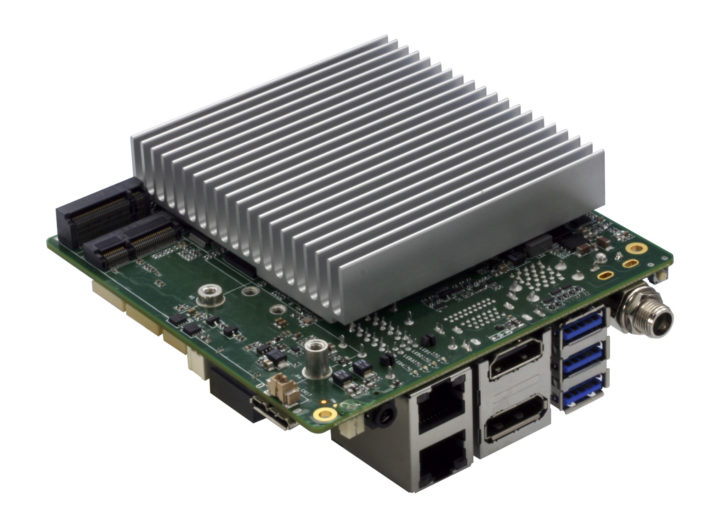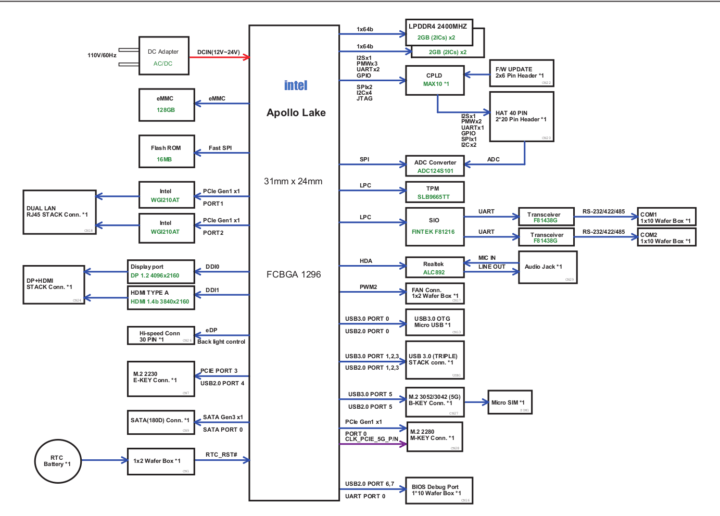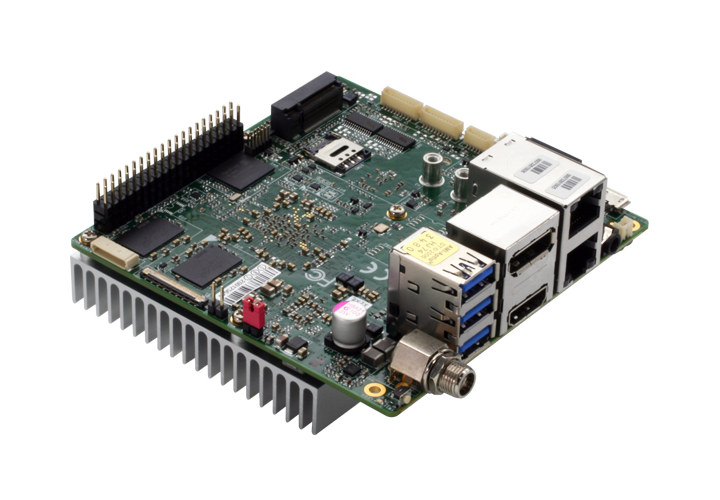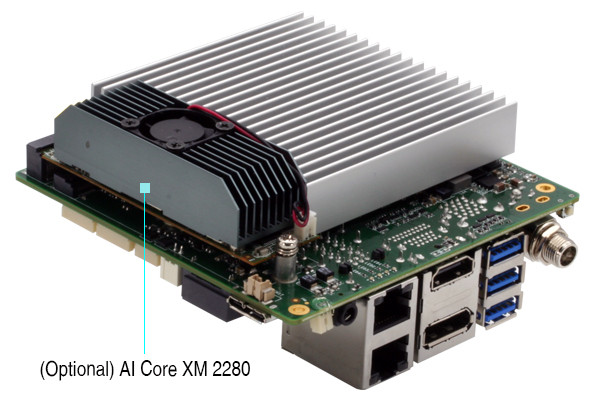UP Squared Apollo Lake SBC was launched in 2016 via a crowdfunding campaign with a price starting at just 89 Euros for the model with 2GB RAM 16GB storage, and a dual-core Intel Celeron N3350 processor.
AAEON has now announced an update simply called UP Squared Pro with many of the same features, but greater expandability and I/O features, for example, to add 5G modules and AI accelerators through one of the three M.2 sockets, as well as improved security via a TPM 2.0 chip.
 UP Squared Pro (UPN-APL01) specifications with highlights in bold or
UP Squared Pro (UPN-APL01) specifications with highlights in bold or strikethrough in comparison to the UP Squared specifications (in 2016):
- SoC (one or the other)
- Intel Celeron N3350 dual-core “Apollo Lake” processor @ 1.1 GHz / 2.4 GHz with 12 EU Intel HD graphics 500 @ 200 MHz / 650 MHz (6W TDP)
- Intel Pentium N4200 quad-core “Apollo Lake” processor @ 1.1 GHz / 2.5 GHz with 18 EU Intel HD graphics 505 @ 200 MHz / 750 MHz (6W TDP)
- Intel Atom x7-E3950 quad-core Apollo Lake processor @ 1.60 GHz / 2.00 GHz with Intel HD Graphics 505 @ 500 / 650 MHz (12W TDP)
- CLPD – Altera Max 10 CPLD
- System Memory – 2, 4, or 8 GB LPDDR4 SDRAM
- Storage –
16,32, 64or 128GB eMMC flash, 1x SATA III port - Video Output –
2x1x HDMI 2.0; 1x DisplayPort 1.2; eDP connector with 12 or 24V power; 3x independent displays support - Audio I/O – 3.5mm audio jack, digital audio via HDMI
- Connectivity – Dual Gigabit Ethernet
- USB – 3x USB 3.2 Gen 1 ports, 1x USB 3.2 Gen 1 OTG port, header with 2x USB 2.0 ports
Camera – 1x 4-lane MIPI CSI connector- Serial – 2x COM port (RS422/RS232/RS485)
- Expansion
- 40-pin GP (general purpose) Raspberry Pi compatible header with GPIOs, I2C, SPI, ADC …
60-pin EXHAT connector with GPIO, I2C, UART, USB 3.0… signals controlled by Altera FPGA and the Intel processor- 1x M.2 2230 E-key slot
- 1x M.2 2280 M-key slot
- 1x M.2 3042/3052 B-key slot
mini PCIe x1 slotHeader with 2x HSUART
- Misc – RTC header, fan, and power connectors, TPM 2.0 security chip
- Power Supply – 12V-24V DC-in (Lockable plug)/ Phoenix connector (optional) up to 5A
5V DC via power barrel - Dimensions – 101.6 x 101.6 mm (was 85.6 x 90 mm)
- Temperature Range – Operating: 0 to 60°C with fan, 0 to 50°C with heatsink
- Certifications – FCC, CE, RoHS, Reach

There are many more changes than I initially expected with different video outputs, support for a wide input voltage range, the addition of an audio jack, etc…, while the camera interface and the mPCIe slot are gone. Some available extension modules include AI Core XM M.2 2280 B+M key AI accelerator card with heatsink and a choice of two M.2 2230 WiFI 5 and Bluetooth modules with antennas.
On the software side, UP Squared Pro SBC can run Microsoft Windows 10, Windows IOT Core, as well as Ubuntu 18.04.5 and Ubuntu 20.04 Linux distributions. The board is also compatible with Intel OpenVINO Toolkit for all machine learning and AI applications.
Typical applications would include Edge AI gateways, drones and autonomous robots, smart surveillance, retail, machine vision applications with, for instance, the ability to detect facial masks or/and enforce proper social distancing in enclosed spaces.
UP Squared Pro can be pre-ordered on UP shop starting at $169 for the dual-core Celeron model with 2GB RAM, and 32GB flash, and up to $319 for the quad-core Pentium variant in 8GB/64GB configuration. Deliveries at scheduled to start later this month. Additional information may be found on the product page.

Jean-Luc started CNX Software in 2010 as a part-time endeavor, before quitting his job as a software engineering manager, and starting to write daily news, and reviews full time later in 2011.
Support CNX Software! Donate via cryptocurrencies, become a Patron on Patreon, or purchase goods on Amazon or Aliexpress. We also use affiliate links in articles to earn commissions if you make a purchase after clicking on those links.







I think you got the dimensions wrong:
Dimensions – 10.16 x 10.16 mm (was 85.6 x 90 mm)
i guess thats cm, mm would be damm small 🙂
What can the CPLD be used for? Especially as the headers it used to control are gone?
Looks promising as an alternative to the out-of-stock ODROID-H2+. With the three M.2 slots, I think you could have an M.2 NVMe SSD (M-key) and two Coral M.2 TPUs (A+E-key and B+M-key).
The ODROID-H2+ is nice though in that it has SATA power connectors and case options that fit 3.5″ HDDs. The UP Squared Pro doesn’t seem to have either. The best option that comes to mind is trying to mount it in a mini-ITX case with a standard ATX power supply and a custom adapter to its power jack. I think it’d be more of a pain to do as well as larger and more expensive.
> a standard ATX power supply and a custom adapter to its power jack
Most probably doubling idle consumption at the wall due to the PSU’s inefficiency. Since you’re talking about SATA did you realize the above thing only exposes 1 SATA channel?
And wrt count of M.2 sockets you better check Apollo Lake restrictions (6 PCIe lanes max) and the block diagram in detail.
For specific use cases the UP would be a significant downgrade compared to ODROID H2+.
Thanks for the reminder to look at the block diagram. I see now the B-key M.2 is USB-only. That’s unfortunate. Otherwise, I don’t really mind having “only” one lane per device. That’s still more bandwidth than most things need.
1 SATA is not ideal but still usable for a NVR (where the data typically aren’t important enough for RAID).
> I don’t really mind having “only” one lane per device
If the block diagram is correct it’s often also just Gen1. Since you compared with ODROID H2+: the key M socket there has 8 times more bandwidth than this UP board (Gen2 x4 vs. Gen1 x1).
> where the data typically aren’t important enough for RAID
Seriously?
The H2+’s Gen2 x4 is massive overkill for my purposes. For me the most exciting thing about it was that (for their recent H2 Net Card) they added BIOS support for using it as “4 bifurcated x1 lanes”. That suggests to me someone could make a cheap single M.2 card with four ($20 each) Coral TPUs. But, sadly, not buy the ODROID-H2+ to put it in.
> where the data typically aren’t important enough for RAID
Sure, we’re talking a budget NVR for a home or maybe a small business. The videos are ephemeral and on average don’t matter. The small fraction that do matter can often be identified by ML analytics, perhaps before even hitting the hard drive. Sometimes later by hand. Those can be auto-uploaded somewhere or kept on the SSD.
Also, I think it’s more common for hard drives under this workload to slowly accumulate bad sectors rather than abruptly fail to spin up, so there’s often some warning the HDD needs replacement.
over 4 years later we have the same soc & about double the price. strange world we live in.
this is strictly for those desperate for an x86 sbc with three M.2 slots…